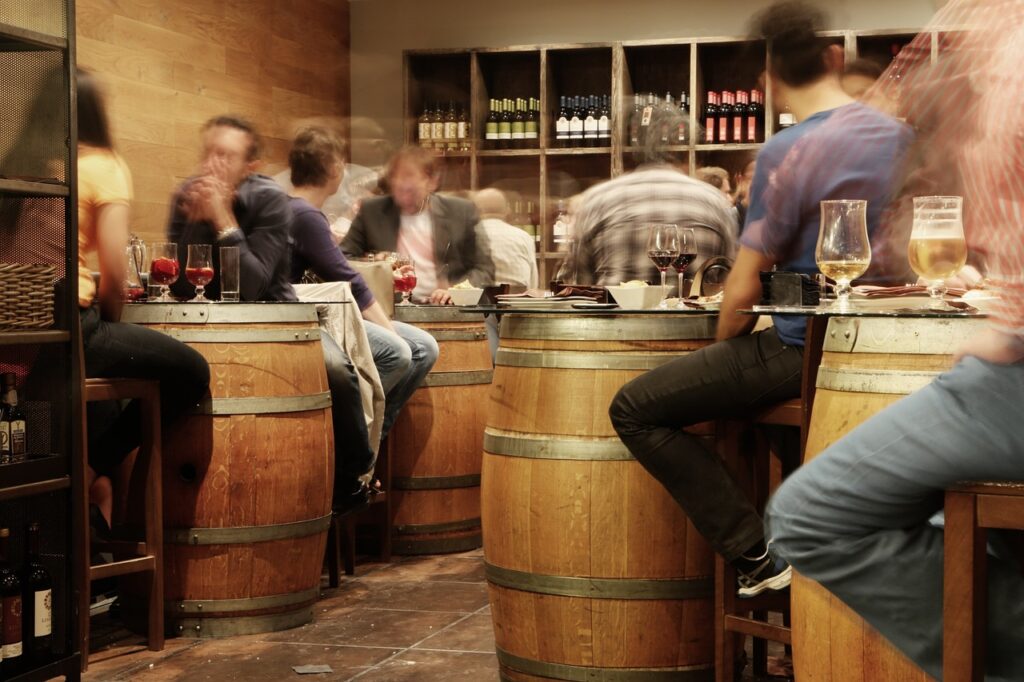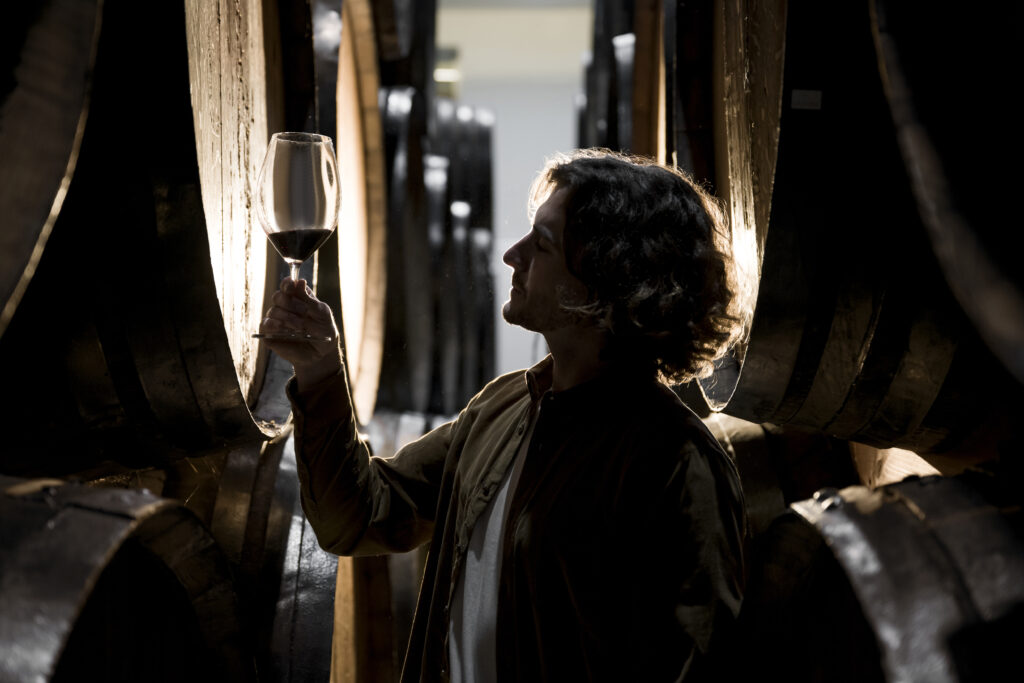Wine tourism is a young industry that is rapidly growing and one that represents a significant commercial and financial interest for wineries. Although wineries utilize many mechanisms to attract potential consumers and to increase in-person visits, some of these mechanisms are changing. Therefore, it is crucial to understand the factors underlying visits to wineries (Byrd et al., 2016; Gu et al., 2020). When the consumer prefers a particular brand of wine, the probability of that consumer visiting the winery where it is produced increases (Gómez et al., 2015). Thus, one should consider how the interface between consumers and wineries can be improved to meet or increase consumers’ brand preferences. Sales of core products like wine can be increased by improving key elements, such as branding. Strengthening a brand may be the best way to achieve the above-mentioned goal (Aaker, 1997; Zehir et al., 2011).

A brand is one of the most valuable assets of any firm that wishes to develop competitive advantages (Schultz et al., 2013). Brands are relevant in consumer markets where firms seek to develop trust, loyalty, and consumer preferences. Consumer brand preference is a critical measure for understanding consumer choice behavior and its influence on purchase or visit intention (Ebrahim et al., 2016; Ye et al., 2017). Building strong brands improves brand preference, so how a brand is communicated, and its image strengthened, may influence brand preference (Ebrahim et al., 2016; Schultz et al., 2013). Brand communication is central to transforming product value into consumer behavior (Dolan & Goodman, 2017). Given the competitive challenges faced by most companies, developing marketing strategies that utilize brand communication is crucial to achieving organizational objectives (Luxton et al., 2015). Most prior studies focused on the communication process, which is defined as integrated marketing communications (IMC), instead of on individual components (Finne & Grönroos, 2017; Madhavaram et al., 2005). In fact, relatively little empirical research has been undertaken to examine the main elements that comprise brand communication (Dwivedi & McDonald, 2018).
Through a review of frameworks, several dimensions of brand communication have been identified that rely on traditional instruments, such as advertising or sponsorship (Buil et al., 2013; Zehir et al., 2011) and social media (Finne & Grönroos, 2017; Godey et al., 2016), as well as novelty components such as corporate social responsibility (CSR) (Türkel et al., 2016). Despite the importance of these elements for branding, scholars highlight the need to further examine the effects of these instruments (Godey et al., 2016). Moreover, since each communication mode has its own characteristics, it is necessary to maintain a balanced approach. Notably, few studies have considered the role of CSR in brand communication (Türkel et al., 2016).

Brand image increases product memory and has several advantages for business expansion (Keller, 1993; Martínez & Pina, 2009). For vineyards, brand preference and, consequently, visit intention are linked to a wine’s quality, attractiveness, and reputation. The variety of wine is also an essential attraction for wine tourists (Bruwer & Buller, 2013). Thus, a well-communicated brand image is important for improving a brand’s position in market competition. Brand communication strategies are crucial for developing a reputation and the image perceived by consumers.
While previous studies have examined the determinants of winery visits (Gómez et al., 2019), most have focused on New-World wine countries (e.g., USA, New Zealand, Australia). Therefore, an opportunity exists to undertake strategic research identifying the drivers of winery visits within Old-World wine-producing countries (e.g., Spain, Italy, France) in the context of branding (Gómez et al., 2019).
Wine Brand Communication
Brand communication is based on the idea that any product or service can be marketed by using elements that distinguish it from those of competitors. Brand communication promotes connections between companies and customers because consumers buy brands that they remember the most (Madhavaram et al., 2005). It is the most relevant element for effectively introducing a new product or service into a market (Schultz et al., 2013).
Brand communication is also a strategic tool that helps companies be more effective in achieving their communication goals. Good brand communication must be driven by responsibility and incorporate both traditional mediums and emerging networks in order to enhance a firm’s competitive advantage (Luxton et al., 2015). Given the incredible growth of social media and its rapid evolution, the advertising environment has led to relevant changes in brand communication theory and practice that highlight the importance of integrating social media and its strategic role (Madhavaram et al., 2005).
Both unidimensional and multidimensional measures have been used for brand communication. Some researchers have conceptualized it as a unidimensional result of both advertising and promotions (Grace & O’Cass, 2005; Zehir et al., 2011). However, the more widespread form of measurement is multidimensional, typically as the sum of two main dimensions: one-way or indirect communication (i.e., print, TV, radio); and two-way or direct communication (Azize 2012). Much of the relevant literature suggests that the main dimensions of brand communication are advertising, sponsorship, and various alternative communication options (Keller, 2003; Madhavaram et al., 2005). Porcu et al. (2017) suggest that brand communication can be measured by the following dimensions: public relations, advertising, direct sales, and promotion.

It is generally accepted that marketers attempt to coordinate offline and online communications comprised mainly of social media (Batra & Keller, 2016). Some authors suggest that messages should be communicated through consistent advertisements, sponsorships, and digital media, as each communication option addresses a different objective. Other researchers highlight the importance of considering the social perspective as multidimensional in the study of brand communication. CSR has emerged as a commonly used marketing tool, since customers view a company more favorably if it promotes social causes (Nan & Heo, 2007; Simmons & Becker-Olsen, 2006). In the actual interactive society, CSR is considered a form of communication (Schultz et al., 2013).
In this research, brand communication is conceptualized as a four-dimensional construct that balances the following traditional and online media elements, including social aspects of them: advertising promotions, sponsorship-public relations, social media and CSR (Dwivedi & McDonald, 2018). These dimensions have been studied individually through customer assessments of brand communication attributes in previous research, i.e.: for advertising promotions (Zehir et al., 2011), for sponsorship-public relations (Chung et al., 2013; Fortunato, 2009), for social media activities (Voorveld, 2019) and for CSR (Nan & Heo, 2007; Westberg & Pope, 2014). Next, we briefly explain the basic features of these four dimensions.
First, advertising and promotions are of particular interest in marketing and consumer behavior (Buil et al., 2013; Grace & O’Cass, 2005; Kwon et al., 2020; Lee et al., 2020). Advertising is a powerful tool for communicating a brand’s functional and emotional value, so it must be appropriately designed and executed to contribute to the creation of a strong brand (Aaker, 1997). Promotion is a mode of advertising intended to increase the sales of a product or service. Advertising can therefore be conceptualized in terms of promotion campaigns and memorability. Many researchers categorize both concepts in the same dimension because they are related (Grace & O’Cass, 2005).
Second, sponsorship and public relations are interrelated and employed to achieve management goals. Although sponsorship is considered a type of public relations (Chung et al., 2013), both can communicate a valuable brand association. Firms choose their sponsorships, which can have a positive effect on brand communication, to achieve public relations objectives (Fortunato, 2009), and a natural fit occurs between them when there is congruence in brand messaging. This congruence is derived from the mission, product(s), market segments and attributes of the product(s), among other factors (Simmons & Becker-Olsen, 2006). Sponsorship is a marketing partnership of two or more brands that are visibly joined to a product or a service (Cornwell & Kwon, 2020). Public relations are defined as activities that project a good image of a company to different stakeholders (Chung et al., 2013; Fortunato, 2009).
Third, social media as a category comprises online social media actions that have been determined to be proper and positive (Kim & Ko, 2012; Kwon et al., 2020). Its development has transformed communication theory and includes consumers as active participants in the process of communication that can even create brand content through blogs or online communities (Batra & Keller, 2016; Finne & Grönroos, 2017). Through social media activities that encourage entertainment, interaction, trendiness, customization, and word-of-mouth recommendations, more personal relationships can be created with consumers (Godey et al., 2016; Tarkang et al., 2020). Social media channels represent an alternative way for firms to communicate, and they are less expensive and more effective for certain targets.
Fourth, CSR is used to assess a brand’s responsibility to its community (Nan & Heo, 2007; Westberg & Pope, 2014). Although there is a lack of consensus on the definition of CSR, most scholars agree that it refers to the social role that a company plays in society, and that it can maximize a company’s image through ethical and social interactions. CSR initiatives should be designed to help all stakeholders achieve personal goals and establish an emotional connection and positive relationships with them. CSR has emerged as a commonly used marketing tool, since customers will view a company more favorably if it promotes social causes (Simmons & Becker-Olsen, 2006).
In the context of wine tourism, wine represents the core attraction, and communication activities that promote this activity are truly important. It is essential to analyze how wine brand communication is carried out using different types of communication strategies. The development of brand communication as a multidimensional concept that can be used in wine market is a novel and great challenge for vineyards (Dolan & Goodman, 2017).
Wine Brand Image
Brand image is defined as a function of how consumers perceive and remember a brand. Brand image is developed by a network of concepts interrelated by associations (Martínez & Pina, 2009), which invokes a set of beliefs about a specific brand that plays a relevant role in a customer’s decision-making process. A customer creates an image from the synthesis of all the symbols used by the brand. Brand image is the result of customers’ interpretations of brand value (Chang & Liu, 2009).
Both qualitative and quantitative methods have been used to measure brand image. The former is frequently applied to explore brand perceptions. Quantitative research employs several types of scales for confirmatory studies (Keller, 1993). Research confirms that brand image has a structure that is more multidimensional than unidimensional (Martínez & Pina, 2009). It is a multifaceted construct (Gómez et al., 2015).
Brand image also includes functional aspects, such as the relationship between consumption and symbolic and experiential needs. According to Biel (1992), brand image consists of three dimensions: corporate image, product/service image and user image. Jara and Cliquet (2012) relate it to tangible attributes (also called functional benefits), symbolic benefits and personality values, among other elements. Following Martínez and Pina (2009), brand image is related to functional image, affective image, and reputation of the brand. These three dimensions have been used to evaluate different products. Thus, in this research, brand image is conceptualized as a multidimensional concept that includes these three dimensions: functional image, affective image, and reputation. Functional image refers to quality requirements that create value. The affective dimension refers to intangible elements that are similar to a personality or a positive association in the customer’s mind. Reputation is the global attitude toward the brand that includes a total evaluation of the company. Reputation refers to an updated image or to distinctive or pervasive elements (Cobb-Walgren et al., 1995).
For wine, brand image is the essence of what wine consumers want or value. Wine brand image is usually associated with quality, and wineries use labels or medals to highlight special. Intangible attributes support the hedonic experience of wine consumption (Bruwer & Rueger-Muck, 2019). Wine brand image is a multidimensional concept involving nature, and it should be studied in depth.
Wine Brand Preference
Brand preference is usually measured by asking customers to specify their favorite brands from a group of selected products/services (Godey et al., 2016; Keller, 2003). Consumer preference for a brand is a function of consumers’ beliefs about the brand’s attributes (Ebrahim et al., 2016). Brand preference indicates the desire to buy a product or service, even when other products or services have the same price and attributes (Cobb-Walgren et al., 1995). This concept is relevant for organizations because it offers a loyalty indicator and points to marketing success. Brand preference is the bias that a consumer has toward a certain brand (Chang & Liu, 2009). Understanding how wine consumers feel about their favorite brands is an interesting topic to study. Wine brand preference can be affected by wine knowledge, which is obtained through information provided by wineries and the recommendations of other wine consumers (Bruwer & Buller, 2013).
Intention to Visit, Revisit and/or Recommend Wineries
Intention to visit refers to the likelihood that a traveler will visit a place. This construct is related to consumers’ attitudes and, thus, is a good measurement of how customers evaluate a brand. However, intention to visit may also refer to a consumer’s plan to visit a place or destination (Chang & Liu, 2009). Intentions are different from attitudes. While attitudes consist of a set of evaluative judgements or predispositions, intentions reveal an individual’s motivation or mindful plan to engage in a behavior regarding a brand. In the wine tourism context, intention to visit implies the intention to visit a new winery, the intention to revisit a winery and/or the likelihood of recommending the visited winery to other people (Ye et al., 2017). It is an important behavioral measure that determines the degree of interest in visiting a winery or a wine region.

This study, carried out by Mar Gómez-Rico, Arturo Molina-Collado, María Leticia Santos-Vijande, María Victoria Molina-Collado and Brian Imhoff
rovides a valuable tool that wine tourism managers can use to attract tourists to wineries. Consequently, this research makes several recommendations for managers wanting to improve the marketing plan in their wineries. Managers can enhance brand preference by managing two important aspects: brand communication and brand image. They should increase their understanding of both concepts to achieve positive brand outcomes.
First, it is vital to fully understand brand communication from an integrative perspective. In order to develop effective brand campaigns, managers should continue to use traditional advertising and promotions, and reinforce sponsorship and public relations, whose effects persist over a longer period (Simmons & Becker-Olsen, 2006). Attending national and international trade fairs is an excellent way to promote brand, both face-to-face and virtually. Developing CSR should also be part of marketing strategy due to its positive effects on brand preference and reputation, especially in the context the COVID-19 pandemic. Finally, social media should be part of the marketing communication agenda, particularly for younger people, who tend to trust conventional advertising less (Dwivedi & McDonald, 2018). Managers should strive to stimulate social media interaction, enhance brand preference and promote the winery’s image, by using interactive digital media, which is known to have a positive effect on brands (Canovi & Pucciarelli, 2019), such as video tasting sessions and blogs. It is important to encourage wine consumers to engage in the creation of brand content in social media communications (Godey et al., 2016; Schivinski & Dabrowski, 2015). Practitioners should consider the findings of this study when developing communication strategies to enhance brand preference and those strategies should be pretested with the target market to maximize potential benefits.
Second, managers should pay attention to the importance of brand image as a strategic tool (Ebrahim et al., 2016), that is, if their goal is to build a strong brand image capable of influencing consumer preference and of stimulating visits to wineries. Thus, managers should improve the functional, affective, and reputational attributes of their vineyards, wines, and wineries. Wine should have a consistent quality over time, and it should be presented with appropriate packaging. Wine should have a strong regional brand, and it must respond to the needs and tastes of its target market. Brand image must be an important long-term strategic tool used by managers to build stronger preferences and, thus, influence the behavioral tendency to repeat visits to wineries.
Following these recommendations will enhance intention to visit wineries. The strength of a brand indicates the importance of the wine brand for wine tourists. Enhancing wine brand preference will induce tourists to provide positive assessments of their visits to wineries. The results of this study strongly suggest that winery managers should focus their efforts on brand preference’s antecedents to improve brand communication and brand image. The findings reveal that managers should make greater investments in their communication resources and branding activities to enhance tourists’ intention to visit.
Gómez-Rico, M., Molina-Collado, A., Santos-Vijande, M.L. et al. The role of novel instruments of brand communication and brand image in building consumers’ brand preference and intention to visit wineries. Curr Psychol 42, 12711–12727 (2023). https://doi.org/10.1007/s12144-021-02656-w

